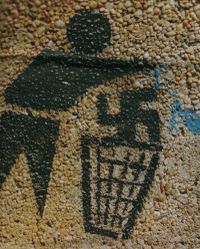Heslach politics
A legacy of anti-fascism
Twelve years of Bismarckian repression ended in September 1890 when the Socialist Laws were repealed. In the following years, the socialist labour movement in Germany experienced a stormy upward trend. The working classes living in Heslach found a political home in the socialist parties, the trade unions and the Naturfreunde movement.
Closely linked to this was the establishment of numerous ‘forest homes’ (Waldheime) as a place of recreation and further education for Stuttgart's working class and their families. During this time, social reform movements also emerged with the aim of improving the housing situation for workers. Urban development projects such as the Südheim colony or the Eiernest estate still characterise the cityscape of Heslach today.
Up to the beginning of the Nazi dictatorship, Heslach was considered the "red Wedding of Stuttgart". Organized workers in Heslach always defied the provocations of reactionary and fascist forces. In the first concentration camps set up by the Nazis in Baden-Württemberg, such as the Oberer Kuhberg concentration camp in Ulm, numerous political opponents from the labour movement such as KPD members, SPD members, trade unionists and church opponents of the regime were incarcerated and tortured from the end of 1933 to the summer of 1935, right at the beginning of the dictatorship. These were not yet extermination camps like Buchenwald, Dachau or Auschwitz later on, and yet it was the cruel beginning of Hitler's dictatorship and paved the way for the Nazi genocide of the Jews of Europe.
The Stuttgart SPD politicians Kurt Schuhmacher and Erwin Schoettle, for example, were two staunch anti-fascists who stood up to the Nazi gang from day one. Alfred Hausser must also be mentioned here. As the son of a working-class family in Stuttgart, Alfred Hausser became a member and later a functionary of the Communist Youth League in 1930. At the age of 22, he was arrested by the Nazis in 1934 and sentenced to 15 years in prison for distributing leaflets against the Hitler regime as a traitor at the notorious People's Court in Berlin. After liberation by the Americans, he returned to Stuttgart and founded the Association of Persecutees of the Nazi Regime / League of Anti-Fascists (VVN) with others. The Jesuit priest Rupert Mayer from Stuttgart took a stand against the Nazis early on. He was banned from speaking by the Nazi authorities from 1935 onwards, arrested several times for sermons critical of the regime and finally sentenced. After his release from Sachsenhausen concentration camp in April 1940, Mayer was to be silenced. He was banned from preaching and placed under house arrest. Mayer was not allowed to leave the Ettal monastery near Garmisch until the end of the war. There are many more examples that need to be remembered, especially today!
